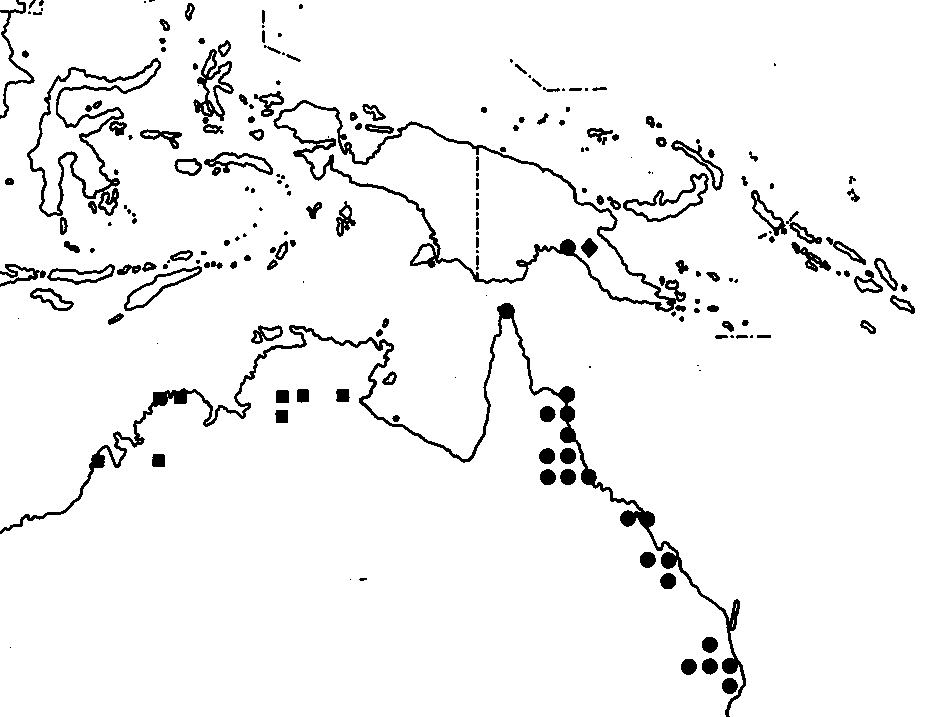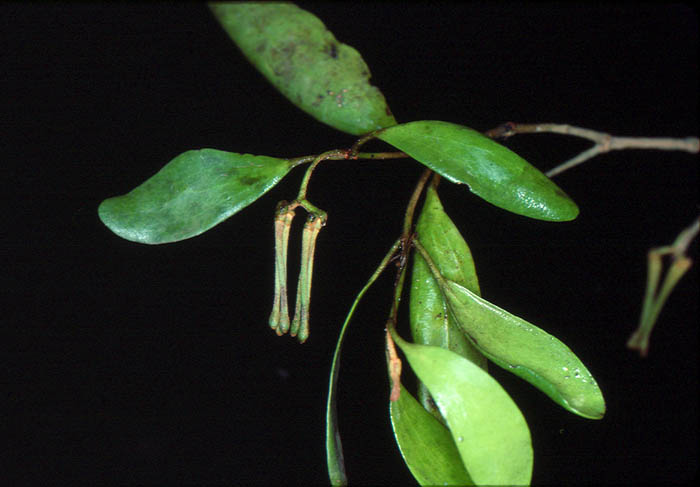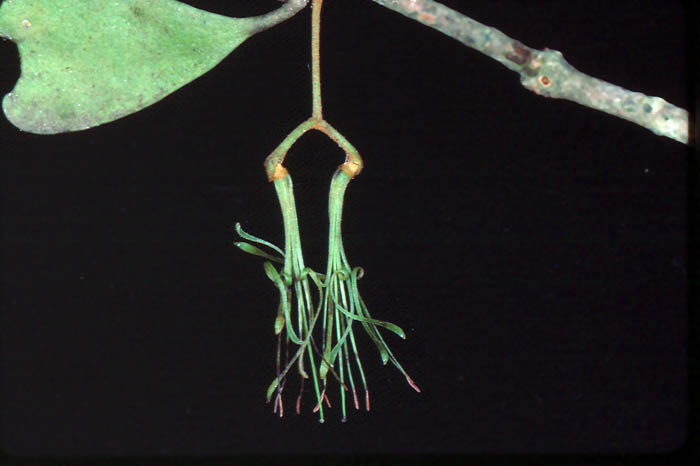
Distribution Map

diamond = A. conspicua subsp. fulvicalyx, circle = subsp. conspicua, square = subsp. obscurinervis.
Description (Barlow 1992)
Loranthus conspicuus F.M.
Bailey, Queensland Agric. J. 26 (1911) 198. - Amyema conspicua
(p.M. Bailey) Danser, Bull. Jard. Bot. Buitenzorg III, 10
(1929) 294. - Type: Bancroft s.n. (holo BRI), Queensland,
Eidsvold, ii.1911.
For description and further synonymy see Barlow, Austral. J. Bot.
22 (1974) 571; Flora of Australia 22 (1984) 101. Amyema conspicua
can be identified locally by its combination of flat petiolate
leaves more than 1 cm wide, 2-rayed umbel of triads with the central
flower sessile, tomentose inflorescence, ovary distinctively white-tomentose
in the lower part, and glabrous corolla. Flower colour is predominantly
green.
The species occurs in New Guinea, Arnhem Land, and eastern Australia
from the Torres Strait islands to northern New South Wales, in
rain forests and open forests, parasitic on many different hosts
(fig. 4). It shows features common in Australian amyemas of open
forests and woodlands (even in New Guinea), including a lack of
epicortical runners, leaves which are curvinerved and isobilateral,
and few-rayed inflorescences. There are three subspecies with
minor differences in leaf and indumenturn characters but strong
ecogeographic separation. Only one subspecies,fulvicalyx Barlow,
was previously recorded for the Flora Malesiana area (Barlow,
1974), from uplands of the Morobe District, Papua New Guinea,
but the present study has revealed the occurrence also of subsp.
conspicua, in the Gulf District of Papua New Guinea, parasitic
on Avicennia.
Additional specimens seen in the present
study have extended the known range of the third subspecies, obscurinervis
Barlow, through the Kimberley region to the northwest coast
of Western Australia. In the western part of its range intergradation
appears to occur with the related species A. benthamii, A.
dolichopoda, and A. villiflora. See note under A.
dolichopoda.
Description (Barlow 1974)
Amyema conspicuum (F. M. Bail.) Dans. Bull. Jard. bot. Buitenz. 10: 294 (1929); Barlow, Aust. J. Bot. 14: 463 (1966); Loranthus conspicuus F. M. Bail. Qd Agric. J. 26: 198, illus. p1. 20 (1911); Blakely, Proc. Linn. Soc. N.S.W. 48: 148, illus. p1. 12 (1923). Type.-Eidsvold, Queensland, T. L. Bancroft, Feb. 1911 (BRI 25329).
Loranthus betchei Blakely, Proc. Linn. Soc. N.S.W. 48: 148, illus. p1. 13 (1923); Amyema betchei (Blakely) Dans. Bull. Jard. bot. Buitenz. 10: 294 (1929).
Type.-Ballina, New South Wales, Bäuerlen 942, Dec. 1892 (NsW 35165).
Glabrous except for the very young parts, inflorescences and calyces white- to brown-tomentose. Leaves opposite; petiole terete, 1-6 mm long; lamina oblong to ovate, 3.5-8 by 1.2-4.5 cm, gradually to abruptly attenuate at the base; rounded at the apex; venation distinctly curvinerved. Inflorescences few to several at the nodes; peduncle (3)-4-6-(9) mm long; rays 2, only slightly divergent, densely tomentose above, glabrous or sparsely tomentose below, 1-2 5 mm long; pedicels of the lateral flowers of the triads with the same tomentum as the rays, 0.5-1 mm long; bracts mostly acute, 1-2 mm long, ciliate. Calyx cylindrical or slightly funnel-shaped, densely white- or pale brown-tomentose below, almost glabrous above; limb entire, 1 mm long. Corolla in the mature bud slender, 14-25 mm long, weakly clavate, acute; petals 5, in the open flower often minutely tomentose on the inside at the tip. Anthers 1.5-2 mm long; free parts of the filaments 6-8-(l 2) mm long. Fruit globular below, 4-5 mm in diam., with a truncate collar 11 .5 mm long. Chrornosome Number.- n = 9 (Barlow 1963).
Occurrence. Eastern
New Guinea, in the vicinity of Wau and Aseki, Morobe district
(Fig. 6), 1200-1400 m altitude. Two other subspecies occur in
Australia, one in Arnhem Land and the other in coastal districts
of Queensland and northern New South Wales.
One subspecies in the area dealt with here
is fulvicalyx.
Amyema conspicuum subsp. fulvicalyx Barlow, subsp. nov.
Type-New Guinea,
Wau, forestry area, 1360 m alt., Barlow 951, 1l.ii.1965
(AD, holotype; L; LAE; BRI).
Partes novelles inflorescentiae bracteae et
calyces dense brunneo-tomentosi. Stolones nulli. Lamina oblongo-spathulata,
36 cm longa, 1-2 cm lata, apice rotundata, basi in petiolum 3-5
mm longum attenuata, margine recurvata. Inflorescentiae fasciculatae,
e nodis foliatus vel defoliatus orti, pedunculatae, umbellatae;
umbellae biradiatae, radiis apice trifioris; pedunculus 6-8 mm
longus; radii 1 . 5-2 5 mm longi; pedicelli 05 mm longi; bracteae
patulae, carinatae, 1 mm longae. Calyx infundibuliformis, 1 .
5 mm longus; limbus 0 7 mm longus, erectus, irregulariter lobatus,
ciliatus. Corolla in alabastro maturo 18-22 mm longa, gracilis,
leniter clavata, acuta. Antherae 5 mm longae; pars liberae filamentae
c. 9 mm longae.
Young parts, inflorescence, bracts and calyx shortly and densely
brown-tomentose, the tomentum of the calyx only at the base and
mixed with white hairs and thus light brown in colour. Stems terete,
much-branched. Leaves opposite; petiole 3-5 mm long; lamina oblong
to obovate, mostly widest above the middle, 3-6 by 1-2 cm, dull
on both sides, attenuate at the base, recurved at the margin,
rounded at the apex; venation distinctly curvinerved. Inflorescences
several in the axils; peduncle 6-8 mm long; rays 2, 1.5-2.5 mm
long; pedicels of the lateral flowers of the triads 0.5 mm long;
bracts spreading, keeled, 1 mm long. Calyx funnel-shaped, 1.5
mm long; limb 0.7 mm long, erect, irregularly lobed, ciliate.
Corolla in the mature bud slender. weakly clavate, acute, 18-22
mm long, 4- or 5-merous. Anthers 1.5 mm long; free parts of the
filaments c. 9 mm long. Fruit more or less globular, 4-5
mm long, with a distinct neck at the apex. Chrornosorne Nurnber.-
n = 9 (Barlow and Wiens 1971), Voucher: Barlow 955.
Occurrence. Near Wau and Aseki, Morobe District, New Guinea (Fig. 6), 1200 to 1750 m altitude.
Specimens Examined. EASTERN NEW GUINEA: Aseki Patrol Area
near Haumnga, Craven and Schodde 1183, 30.iii.1966 (cANB);
McAdam Park near Wau, 1200 m alt., Barlow 955, 11.ii.1965
(AD; L LAE; BRI).
Amyema conspicuum subsp.
fulvicalyx is similar to subsp. conspicuurn of coastal
Queensland and New South Wales, differing in the dark tomentum
and the thin narrow leaves which are widest above the middle.
In common with A. mackayense, which also has a wide distribution
in Australia, this form is distinct among the New Guinea Amyemas
in lacking runners, a condition more or less typical of the Australian
species of the genus.
Illustrations
Photographs

Plant with flower buds. (DLN 2814). Parasitic on Flindersia acuminata. Lake Eacham, at concession/beach area, Queensland, Australia. Photo by Dan Nickrent.

Same as above, flowers open. Photo by Dan Nickrent.
Amyema conspicua
updated 18 January 2007